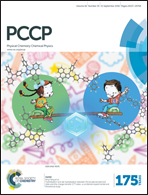Theoretical insight into the wavelength-dependent photodissociation mechanism of nitric acid†
Abstract
Photodissociation pathways of HNO3 involving the four lowest electronic singlet states (S0, S1, S2 and S3) were studied by the MS-CAS(12e,8o)PT2/6-31+G* method. All critical points, i.e. minima, transition states and minimum energy conical intersections, were explored systematically by the global reaction route mapping (GRRM) strategy utilizing the anharmonic downward distortion following (ADDF) method. Some key structures were also optimized at the MS-CAS(16e,12o)PT2/aug-cc-pVDZ level. Based on structures and relative energies of these critical points, we discussed the wavelength-dependent photodissociation mechanism of HNO3 in detail. The OH(X2Π) dissociation was found to occur through four pathways on the S1, S2, and S3 surfaces depending on the excitation energy, and one of the four pathways was shown to undergo the excited state roaming mechanism. The experimental appearance energy of the O(1D) dissociation channel at 538.8 kJ mol−1 was attributed to a conical intersection between the S2 and S3 surfaces. It has been shown experimentally that the O(1D) channel was dominant at the higher excitation energy. In this study, its mechanistic reason was explained by the shape of the S3 surface and locations of important critical points.


 Please wait while we load your content...
Please wait while we load your content...